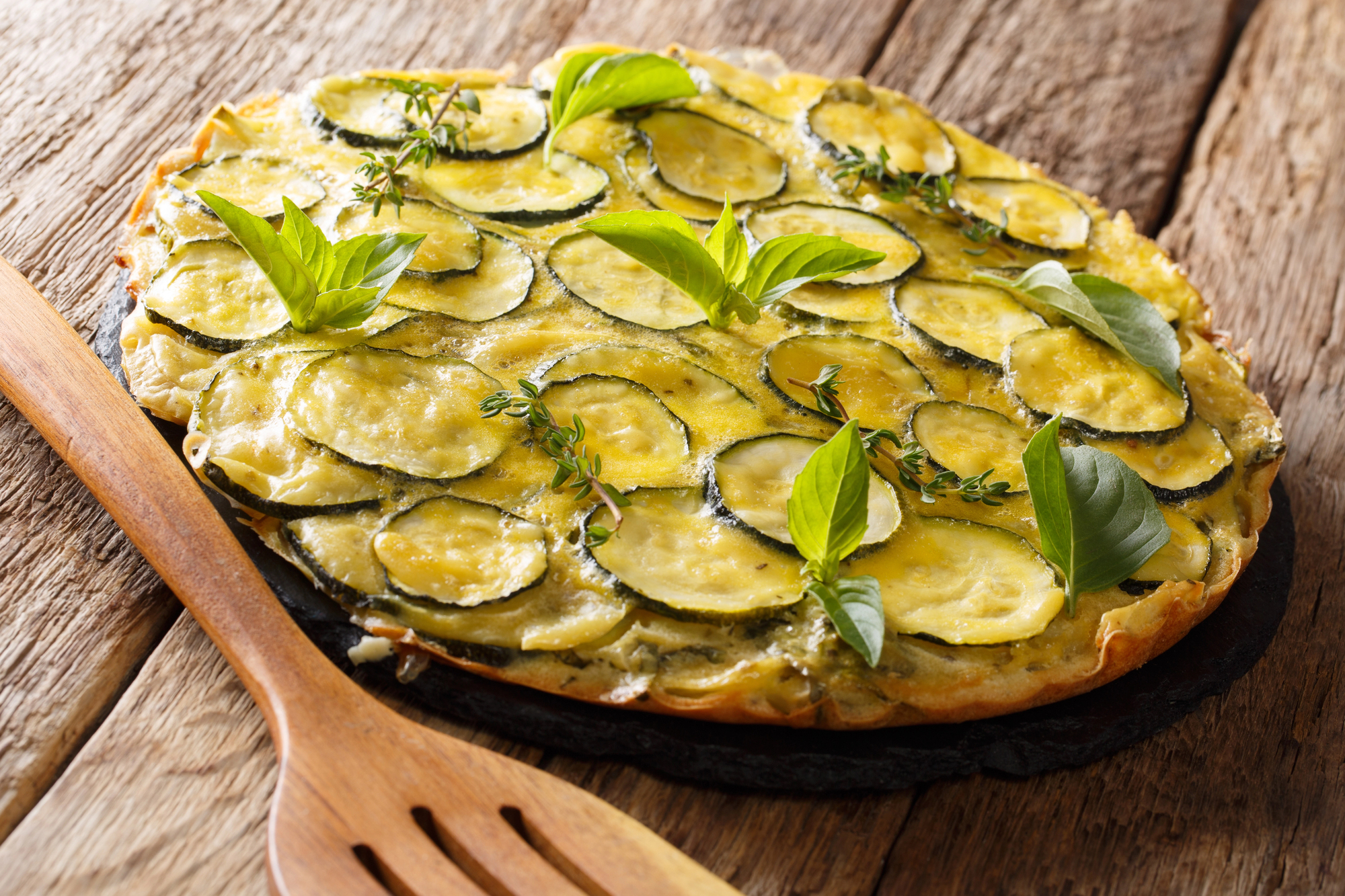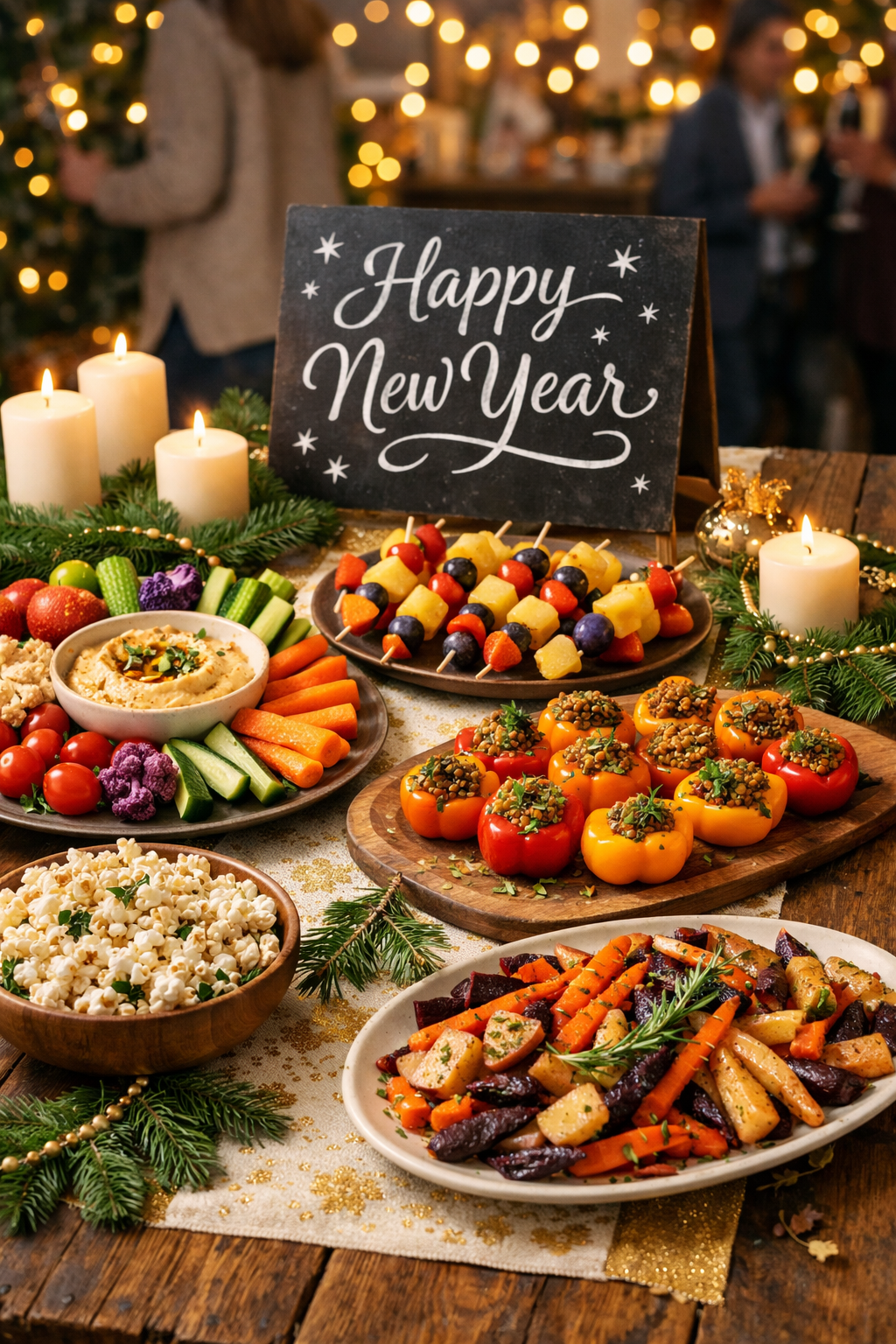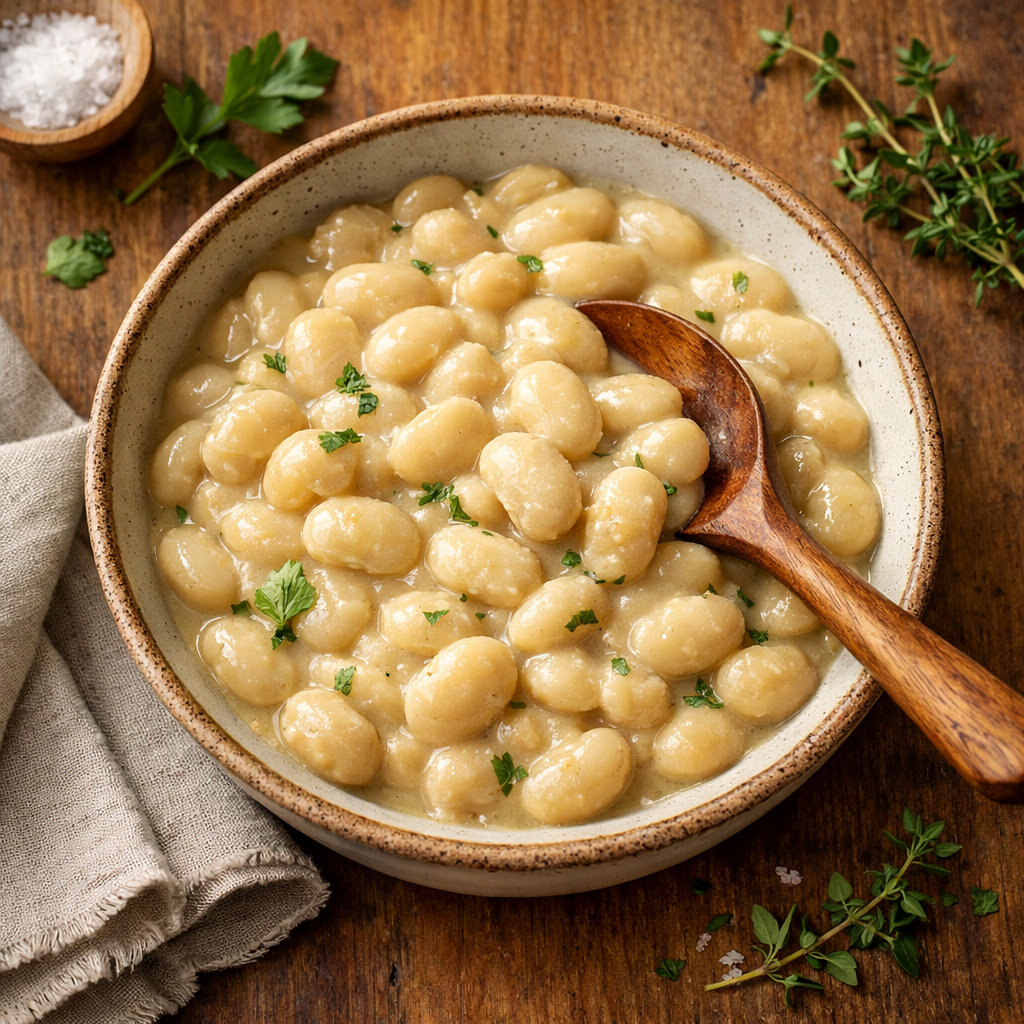As I prepare to graduate from my health and wellness course in the next few weeks, I find myself reflecting on the incredible journey these past six months have taken me on. The training and learning experience, while intensive, feels like just the beginning—six months simply isn’t enough to master everything about nutrition and wellness. However, it has opened my eyes to the profound connection between traditional cuisines and healthy living. I will continue the advocacy on healthy living by sharing discoveries like zucchini scarpaccia, a rustic Tuscan masterpiece that perfectly embodies the Mediterranean approach to nutritious, satisfying meals.
This humble, yet extraordinary, dish has become one of my favorite examples of how traditional cooking can align beautifully with modern wellness principles. When zucchini reaches its peak season and gardens overflow with this versatile vegetable, there’s no better way to celebrate summer’s bounty than with this crispy, golden tart that transforms simple ingredients into something truly wonderful.
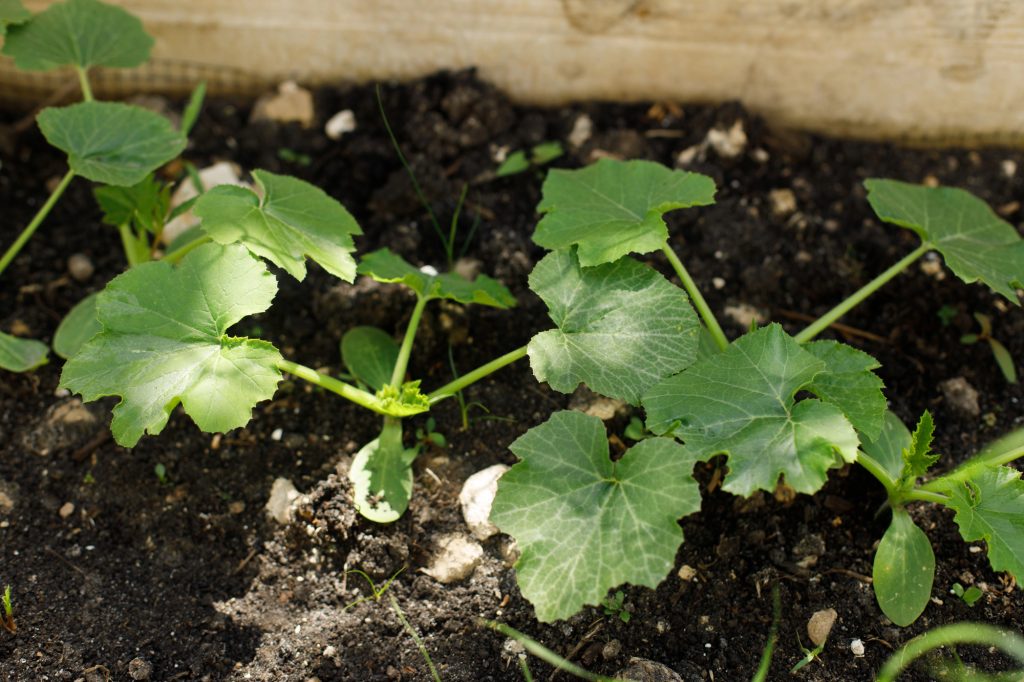
I owe my appreciation for home-grown zucchini to my stepmom. I’ve come to appreciate not just the final dish, but the entire journey from garden to table.
What Makes Zucchini Scarpaccia So Special?
Zucchini scarpaccia represents everything beautiful about Italian cooking—it’s uncomplicated, uses seasonal ingredients, and delivers maximum flavor with minimal preparation. This traditional Tuscan flatbread is essentially a thin, crispy tart that showcases zucchini in its most delicious form. The name itself tells a story: “scarpaccia” translates to “old shoe” in Italian, referring to its flat, rustic appearance that mirrors a well-worn piece of leather.
The beauty of this dish lies in its simplicity. Unlike heavy, cream-laden casseroles or complex layered dishes, scarpaccia allows the natural sweetness of zucchini to shine through. The vegetables are thinly sliced and bound together with a light batter made from flour, cornmeal, liquid ingredients, and aromatic herbs . When baked, the edges become delightfully crispy while the center remains tender, creating a textural contrast that’s absolutely addictive.
What makes this dish particularly appealing from a wellness perspective is its versatility. It works equally well as a light lunch, an elegant appetizer, or a healthy side dish. The high vegetable content means you’re getting plenty of nutrients while the satisfying texture ensures you won’t feel deprived. It’s the kind of food that nourishes both body and soul—exactly what we should be aiming for in our daily meals.
The Rich History and Origins of This Tuscan Treasure
The story of scarpaccia takes us back to the heart of Tuscany, specifically to the coastal regions of Viareggio and Camaiore in the province of Lucca. Like many of Italy’s most beloved dishes, it was born from necessity rather than luxury. Legend suggests that this remarkable tart was invented in the 1300s when a local lord, faced with limited provisions, combined zucchini, flour, and eggs to create something substantial and delicious from humble ingredients.
This origin story perfectly captures the essence of Italian peasant cuisine—the ability to transform simple, affordable ingredients into something extraordinary. The dish evolved over centuries, with each region adding its own touch. Today, we find two main variations: the Scarpaccia Viareggina, which leans slightly sweet and sometimes serves as a dessert, and the Scarpaccia Camaiorese, the savory version that focuses on vegetables and herbs.
The historical significance of this dish extends beyond mere sustenance. It represents the Italian philosophy of eating seasonally and locally, using whatever the land provides. During summer months when zucchini plants produce abundantly, families would rely on recipes like this to make the most of their harvest. This approach to cooking—seasonal, sustainable, and deeply connected to the land—is precisely what modern wellness advocates are rediscovering.

Essential Ingredients for Perfect Scarpaccia
Creating authentic zucchini scarpaccia requires surprisingly few ingredients, but each one plays a crucial role in the final result. The star, of course, is fresh zucchini—ideally young, tender vegetables that haven’t developed large seeds or tough skin. The key is slicing them paper-thin, preferably with a mandolin, to ensure even cooking and that signature delicate texture.
💡 Pro Tip: The secret to that ultra-crispy, delicate scarpaccia lies in perfectly thin zucchini slices. This Vollum Wide Mandoline Slicer makes the job effortless. It’s sharp, adjustable, and built to last—ideal for precision slicing when texture really matters.

Wide Mandoline Slicer Professional Japanese Mandoline Slicer with Interchangeable Stainless Steel Blades
- A Must for Cooking Enthusiasts: Whether a professional chef or you enjoy surprising family and friends with delicious, well-balanced home cooked meals, the Vollum cucumber slicer is the perfect addition to any modern kitchen, making an excellent gift idea for wedding registry, birthday, anniversary and more!
- Premium Grade Construction: Our veggie slicer is made employing superior quality, durable materials, a combination of heavy duty non-BPA food-grade plastic and rustproof dishwasher safe stainless steel metal, designed to withstand the test of time and intensive use
- Different Size Interchangeable Blades: Unlike similar products on the market, this food slicer comes with 3 easily interchangeable blades, providing different levels of serration, fine, medium and coarse, depending on your needs.
- Endless Possibilities: The Vollum mandoline slicer is incredibly versatile and can be used to slice a wide range of veggies and fruits, from potatoes, zucchinis, apple, tomatoes, cucumbers, carrots, and much more, saving your time and energy during cooking!
The base batter combines all-purpose flour with cornmeal, which gives the tart its characteristic golden color and subtle crunch. Eggs bind everything together while adding richness and helping achieve that perfect crispy exterior. Italian cooks traditionally use either Parmesan or Pecorino cheese, both of which contribute a nutty, salty depth that complements the mild zucchini perfectly.
Fresh herbs are where you can really make the dish your own. Classic combinations include oregano, rosemary, and basil, but don’t hesitate to experiment with thyme, dill, or whatever herbs are thriving in your garden. Garlic powder adds warmth, while good-quality olive oil ensures those coveted crispy edges and carries the flavors throughout the dish.
Onions—typically red or sweet varieties—add another layer of flavor and help create the dish’s complex taste profile. Some cooks include a touch of black pepper and sea salt, but the beauty of scarpaccia lies in its restraint. Each ingredient should be able to shine without overwhelming the others.
For those following specific dietary requirements, this recipe adapts beautifully. Vegan versions substitute nutritional yeast for cheese and use flax eggs or aquafaba instead of chicken eggs. Gluten-free adaptations work wonderfully with rice flour or specialized gluten-free flour blends, making this dish accessible to almost everyone.
Mastering the Art of Preparation
The secret to exceptional scarpaccia lies in proper preparation, particularly in handling the zucchini. This step cannot be rushed or skipped—it’s what separates a soggy disappointment from a crispy triumph. After slicing your zucchini paper-thin, generously salt the slices and place them in a colander. This draws out excess moisture, which is crucial for achieving that desired crispy texture.
The salting process can take anywhere from 15 minutes to 2 hours, depending on your schedule and the moisture content of your zucchini. During this time, the vegetables will release liquid, which you should save—this flavorful zucchini water becomes part of your batter, ensuring no flavor is wasted. After the salting period, gently squeeze the zucchini slices to remove even more moisture.
While the zucchini drains, prepare your batter by whisking together flour, cornmeal, herbs, spices, salt, and pepper. The consistency should be smooth but not too thick—think of a pancake batter. Gradually add the reserved zucchini liquid, olive oil, and beaten eggs, whisking constantly to prevent lumps. The batter should be fluid enough to coat the vegetables easily but substantial enough to hold everything together during baking.
The assembly process is where the magic happens. Gently fold the drained zucchini and thinly sliced onions into the batter, ensuring each piece is evenly coated. Line a baking tray with parchment paper and brush generously with olive oil—this prevents sticking and promotes browning. Spread the mixture in an even layer, keeping it thin for maximum crispiness. The ideal thickness is no more than 1 centimeter; any thicker and you risk a soggy center.
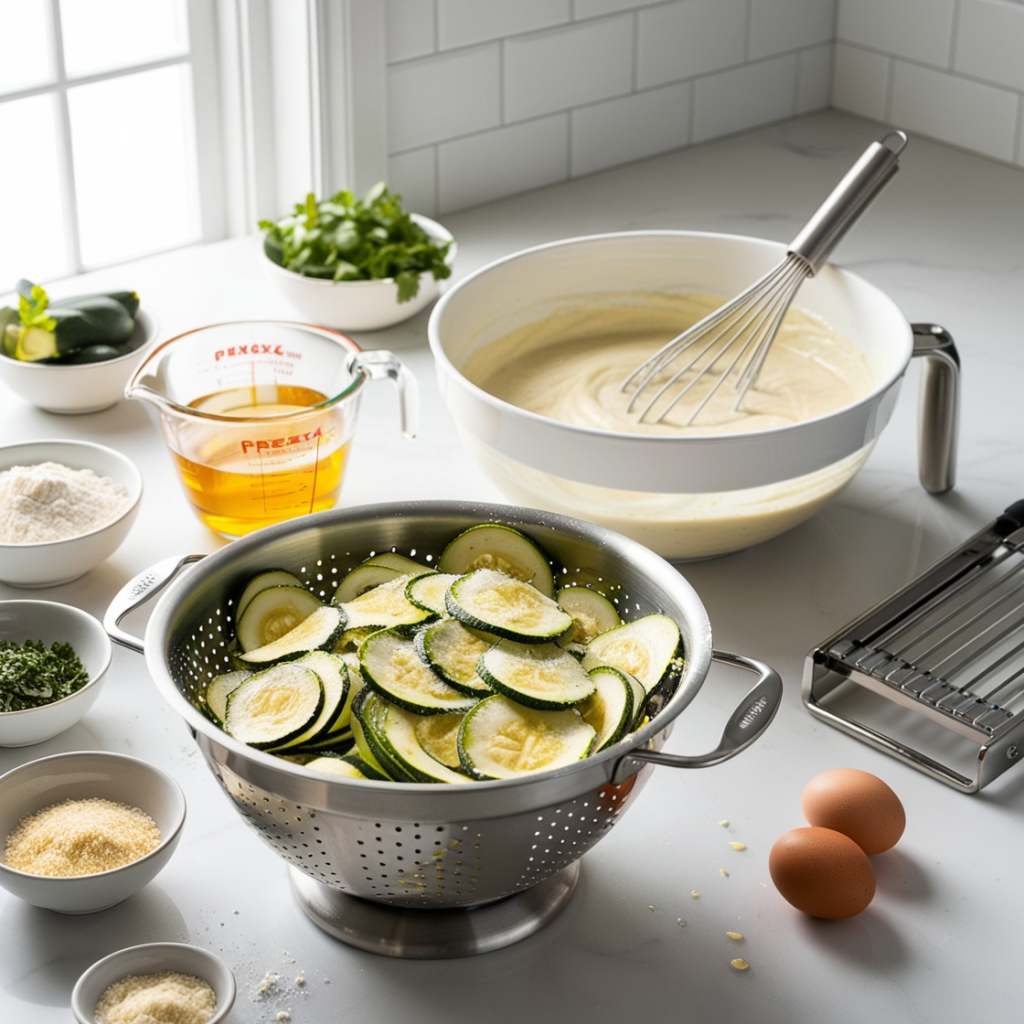
Traditional Zucchini Scarpaccia Recipe
Ready to bring this Tuscan treasure to your own kitchen? Here’s my tried-and-tested recipe that delivers authentic flavors and that perfect crispy texture every time.
Ingredients:
- 2 pounds (900g) fresh zucchini, thinly sliced
- 1 large red onion, thinly sliced
- 1 cup zucchini flour
- ½ cup cornmeal or fine polenta
- 3 flax eggs (3 tablespoons ground flaxseed mixed with 9 tablespoons water)
- ¾ cup plant-based milk mixed with 1 tablespoon apple cider vinegar
- ½ cup freshly grated Parmesan cheese
- ¼ cup extra virgin olive oil, plus extra for the pan
- 2 tablespoons fresh oregano (or 1 tablespoon dried)
- 1 tablespoon fresh rosemary, finely chopped
- 2 cloves garlic, minced (or 1 teaspoon garlic powder)
- ½ teaspoon sea salt
- ½ teaspoon black pepper
- Fresh basil leaves for garnish
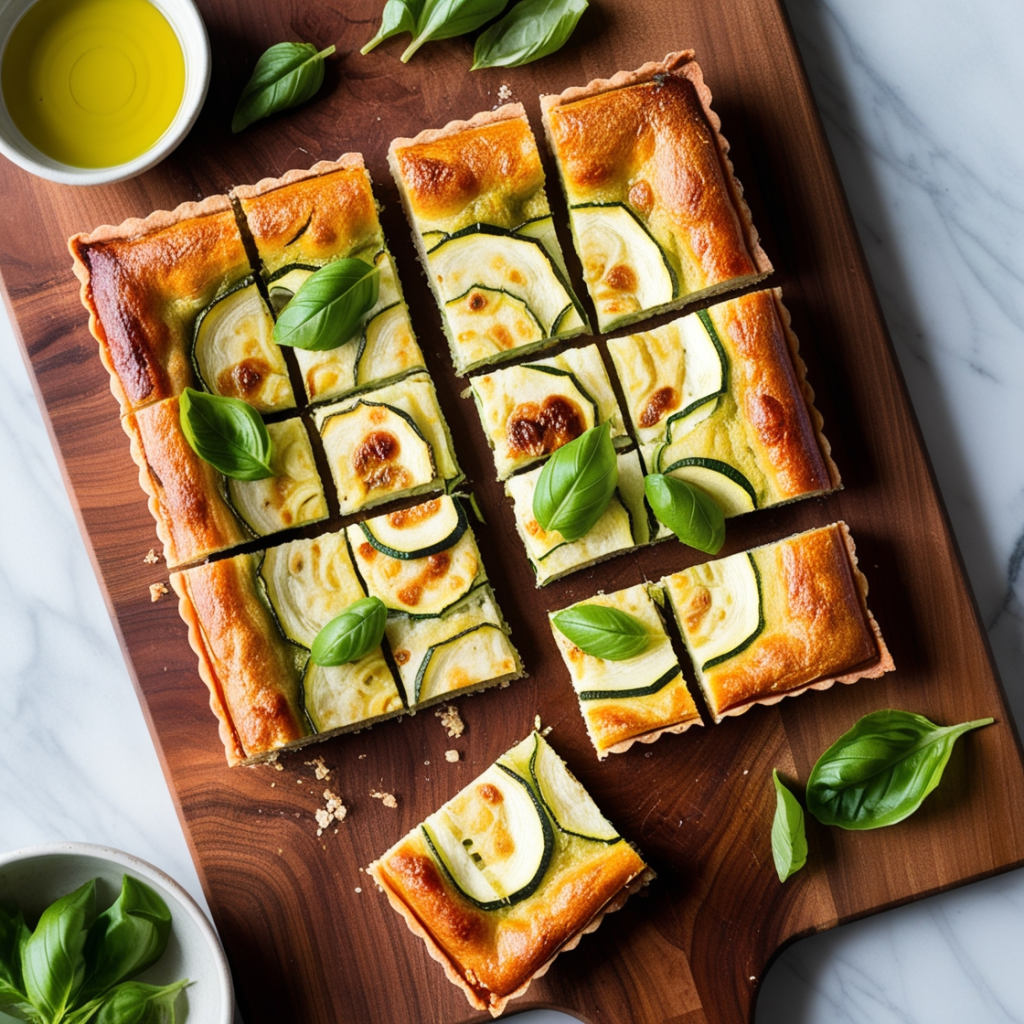
Instructions:
Prepare the Flax Eggs
- In a small bowl, mix 3 tablespoons ground flaxseed with 9 tablespoons water
- Set aside for 10-15 minutes to thicken and become gel-like
Get the Zucchini Ready
- Using a mandolin or sharp knife, slice zucchini into paper-thin rounds (about ⅛ inch thick)
- Place slices in a large colander and sprinkle generously with 1 teaspoon salt
- Toss to distribute salt evenly and let drain for 30 minutes to 2 hours
- Reserve the liquid that drains out—you’ll need about ½ cup for the batter
- Gently squeeze zucchini slices to remove excess moisture
Make the Batter
- In a large bowl, whisk together zucchini flour, cornmeal, oregano, rosemary, garlic, sea salt, and black pepper
- In a separate bowl, combine the reserved zucchini liquid, prepared flax eggs, plant-based milk mixture, and ¼ cup olive oil
- Gradually add the wet ingredients to the dry ingredients, whisking until smooth
- The batter should be the consistency of thick pancake batter (add more plant-based milk if too thick)
Assemble
- Preheat oven to 425°F (220°C)
- Line a large baking sheet or 9×13 inch pan with parchment paper
- Brush generously with olive oil
- Gently fold the drained zucchini, sliced onions, and Parmesan cheese into the batter
- Spread mixture evenly on prepared pan, keeping it thin (no more than 1 cm thick)
Bake
- Bake for 35-45 minutes, until edges are golden brown and crispy
- The center should feel set when gently pressed
- Let cool for 5-10 minutes before slicing
Serve
- Cut into squares or wedges
- Garnish with fresh basil leaves
- Serve warm or at room temperature
- Drizzle with extra olive oil if desired
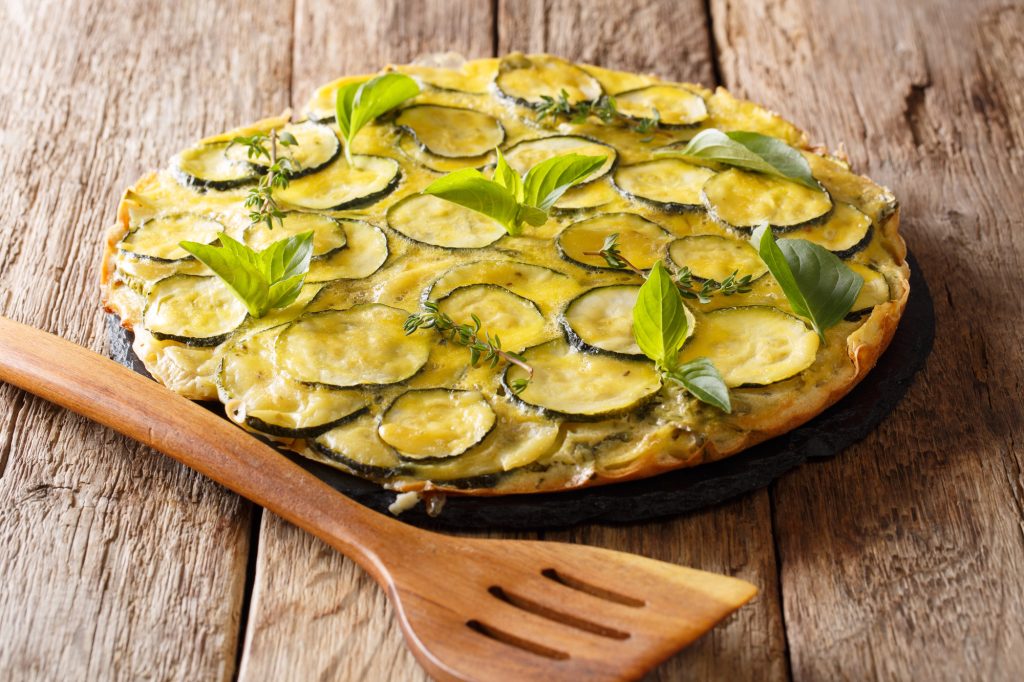
Chef’s Notes:
- For extra crispiness, use a metal pan instead of glass
- Don’t skip the salting step—it’s crucial for texture
- Zucchini flour may absorb more liquid than regular flour, so adjust plant-based milk as needed
- Leftover scarpaccia can be reheated in a skillet to restore crispiness
- For completely vegan version: Use nutritional yeast instead of Parmesan cheese
- The flax eggs need time to gel, so prepare them first
Prep Time: 45 minutes (including draining time)
Cook Time: 35-45 minutes
Total Time: 1 hour 30 minutes
Serves: 6-8 as an appetizer, 4 as a main dish
Tips for Scarpaccia Success
Achieving restaurant-quality results at home requires attention to a few key details. First, invest in a good mandolin slicer if you don’t already have one. Uniform, paper-thin slices are essential for even cooking and the proper texture. If you must use a knife, take your time and aim for consistency—uneven pieces will cook at different rates, leading to some burnt edges and undercooked centers.
🍽️ For extra crispiness: A top-notch baking pan makes all the difference. The USA Pan Bakeware Rectangular Pan – Heavy-Duty Nonstick, Warp-Resistant delivers beautifully golden edges and even heat distribution—essential for achieving that perfectly crispy scarpaccia.

USA Pan 3-Piece Warp Resistant Non-Stick Aluminized Steel Bakeware Set
- 3 piece bakeware set includes: 17 x 12. 25 inch cookie sheet, 12. 5 x 9 inch quarter sheet pan and 17. 25 x 12. 25 inch half sheet baking pan
- Baking Sheet pans are all finished with USA Pan’s proprietary silicone nonstick Americoat coating which allows for superior baking, easy release and quick clean up
- Made from Aluminized steel; a mix of steel for strength and durability and aluminum for superior heat conductivity
- Unique, ridged texture, facilitates even air circulation and heat distribution for uniformly baked goods
Temperature control is crucial. Most recipes call for baking at 400°F to 425°F (200°C to 220°C), but every oven is different. Start at the lower temperature and increase if needed. The scarpaccia is ready when the edges are golden brown and crispy, and the center feels set when gently pressed. This usually takes 30 to 45 minutes, but keep a close eye during the final 10 minutes.
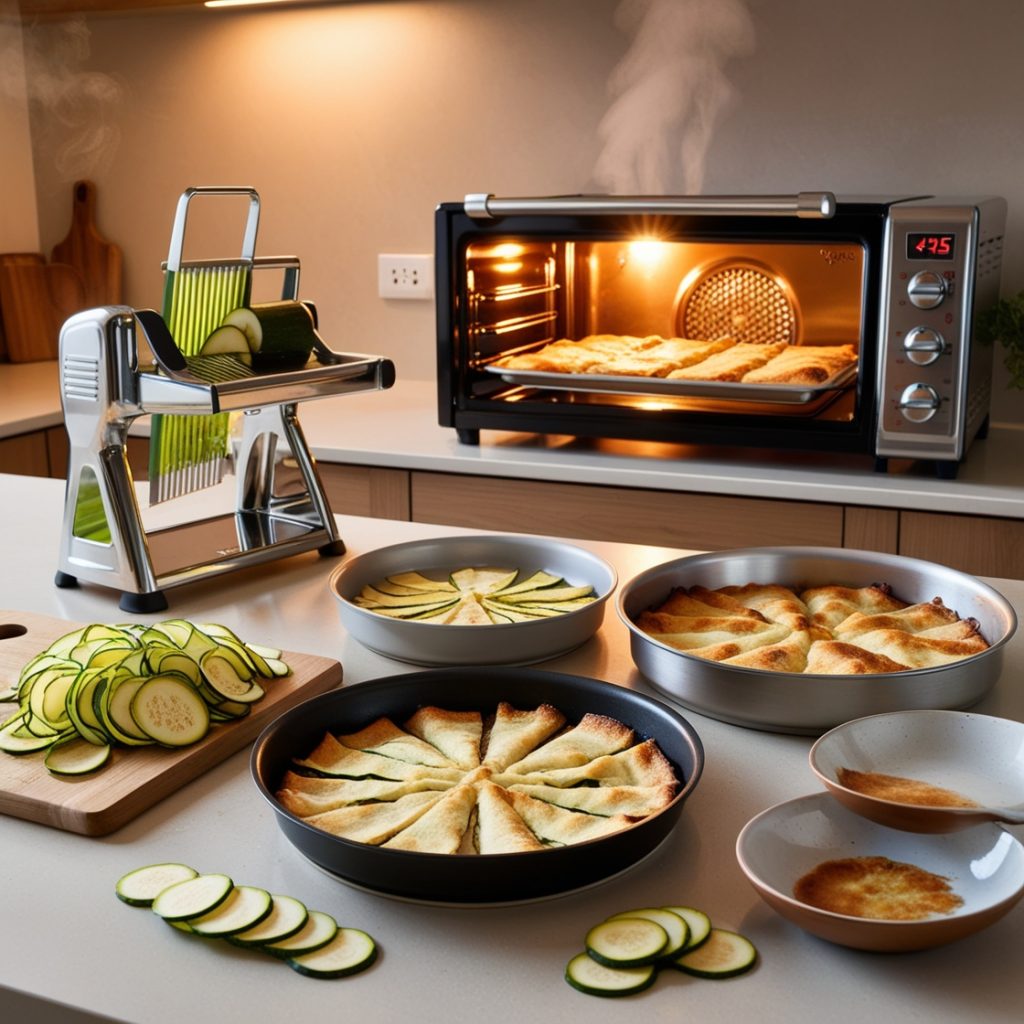
The type of baking surface matters more than you might think. A metal pan conducts heat better than glass or ceramic, resulting in superior browning and crispier edges. If you only have glass dishes, consider preheating the pan in the oven before adding the mixture—this gives you a head start on the crisping process.
Don’t be tempted to check on your scarpaccia too frequently during the first 20 minutes of baking. Opening the oven door releases heat and can cause the center to remain undercooked while the edges burn. Trust the process and let the oven do its work.
Serving Suggestions and Flavor Pairings
One of the most appealing aspects of zucchini scarpaccia is its incredible versatility. As an appetizer, cut it into neat squares and arrange on a wooden board with other Mediterranean bites like olives, fresh mozzarella, and crusty bread. The rustic presentation adds to its charm and makes it perfect for casual entertaining.
For a light lunch or dinner, serve generous wedges alongside a simple arugula salad dressed with lemon vinaigrette. The peppery greens provide a nice contrast to the mild, sweet zucchini, while the acidity brightens the entire meal. A glass of crisp white wine, such as Pinot Grigio or Sauvignon Blanc, complements the dish beautifully. My husband Bruce and I spent one Saturday evening enjoying this perfect pairing, and it became one of our favorite ways to unwind together.
As a side dish, scarpaccia pairs wonderfully with grilled meats, particularly chicken, lamb, or fish. It also makes an excellent accompaniment to soups, especially during the transition from summer to fall when you want something warming but not heavy. Italian families often serve it alongside pasta dishes, where it functions almost like a rustic bread.
For those who enjoy dipping sauces, consider serving small bowls of marinara, pesto, or simply good olive oil mixed with sea salt and herbs. The crispy edges of the scarpaccia make it perfect for scooping, while the tender center holds up well to light sauces.
For a finishing touch, I love drizzling a bit of high-quality extra virgin olive oil over each slice of scarpaccia—it adds richness and ties all the flavors together.
🌿 Elevate your Mediterranean meals with the right olive oil. This Partanna EVERYDAY Organic Unfiltered Cold-Pressed Olive Oil brings authentic Sicilian flavor to your kitchen. Rich, smooth, and full of antioxidants, it’s perfect for drizzling over scarpaccia, salad greens, or dipping with rustic bread.
Partanna Organic Unfiltered Extra Virgin Olive Oil – Premium Organic Castelvetrano Oil Harvested in Sicily – Pure Authentic Italian – Monovarietal – Rich in Flavor and Tradition – 101oz (3 liter) Tin
- ORGANIC AND UNFILTERED: This exceptional Sicilian Extra Virgin Olive Oil is organic and unfiltered, ensuring you get the purest and most natural product possible.
- EXCEPTIONAL FLAVOR: Made from 100% Castelvetrano olives, this EVOO offers a distinctive buttery flavor and a rich, luxurious texture.
- HIGHER ANTIOXIDANT LEVELS: Because it is unfiltered, this olive oil contains small amounts of olive pulp and sediment, which contribute to its higher levels of antioxidants and polyphenols compared to filtered olive oils.
- FTRADITIONAL CRAFTSMANSHIP: Partanna Sicilian Organic Unfiltered EVOO is produced using time-honored methods passed down through generations.
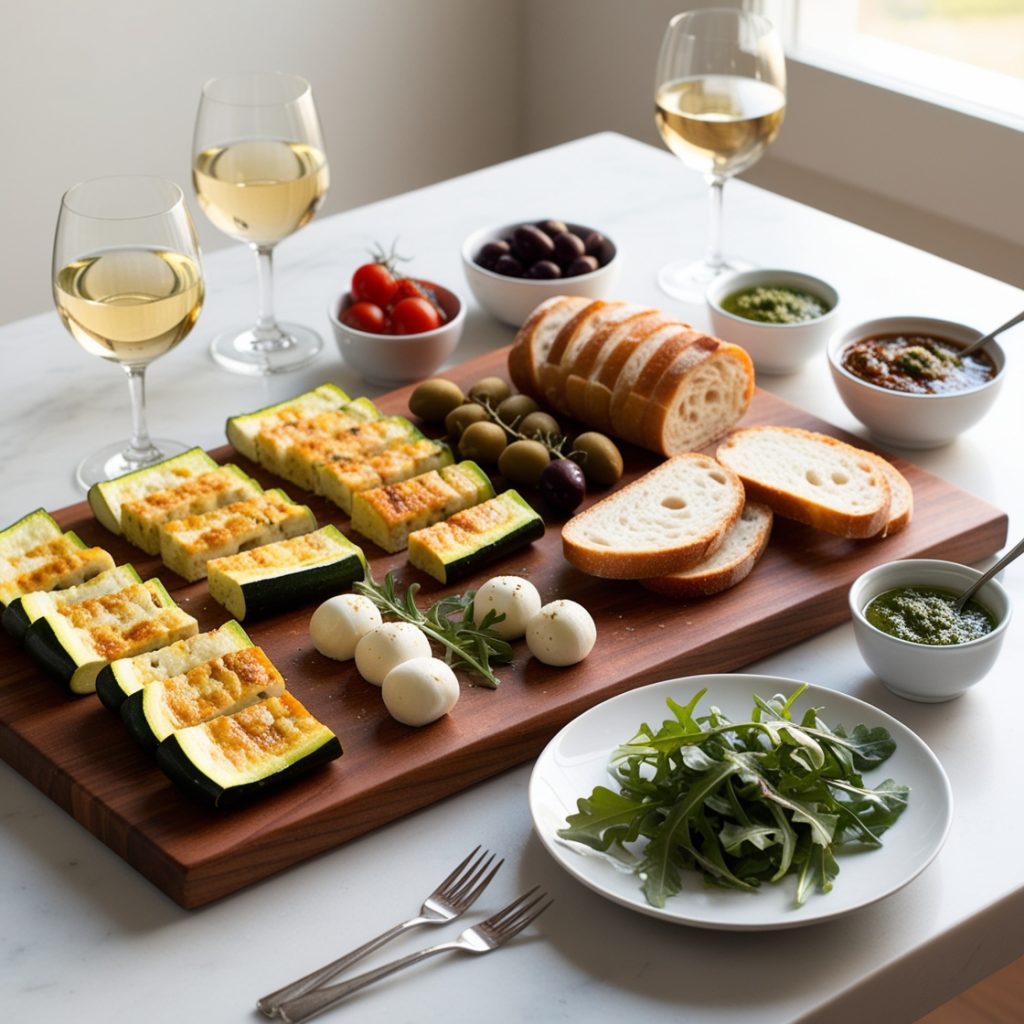
The Wellness Benefits of This Tuscan Treasure
From a nutritional standpoint, zucchini scarpaccia offers impressive benefits that align perfectly with modern wellness principles. Zucchini itself is remarkably nutrient-dense while being naturally low in calories. A single cup provides significant amounts of vitamin C, potassium, and antioxidants, all while containing fewer than 20 calories.
The high water content of zucchini helps with hydration, while its fiber content supports digestive health. The vegetable also contains folate, vitamin A, and manganese—nutrients that support immune function and overall health. When you consider that this dish is essentially a vehicle for consuming large amounts of vegetables, its nutritional value becomes even more impressive.
The traditional preparation method preserves most of these nutrients while making them more bioavailable. The addition of olive oil, rich in healthy monounsaturated fats, helps the body absorb fat-soluble vitamins. The herbs provide additional antioxidants and anti-inflammatory compounds, turning this simple dish into a nutritional powerhouse.
Unlike many modern processed foods, scarpaccia contains no artificial additives, preservatives, or refined sugars. It’s naturally vegetarian and can easily be adapted for vegan or gluten-free diets without sacrificing flavor or nutrition. This accessibility makes it an excellent choice for anyone looking to improve their diet while still enjoying delicious, satisfying food.
Embracing the Mediterranean Way of Eating
As I continue my advocacy for healthy living, dishes like zucchini scarpaccia remind me why the Mediterranean diet has gained such recognition in wellness circles. This isn’t about restriction or deprivation—it’s about celebrating fresh, seasonal ingredients and preparing them in ways that honor both tradition and nutrition.
The Mediterranean approach to eating emphasizes plant-based foods, healthy fats, and moderate portions—principles that are beautifully embodied in this simple Tuscan tart. It’s food that nourishes the body while satisfying the soul, proof that healthy eating doesn’t have to be complicated or joyless.
This dish also represents something deeper: the connection between food, culture, and community. In Italy, sharing meals is about more than just nutrition—it’s about bringing people together, celebrating the seasons, and maintaining traditions that have sustained families for generations. When we make scarpaccia, we’re not just preparing dinner; we’re participating in a culinary tradition that spans centuries.
A Lasting Impression
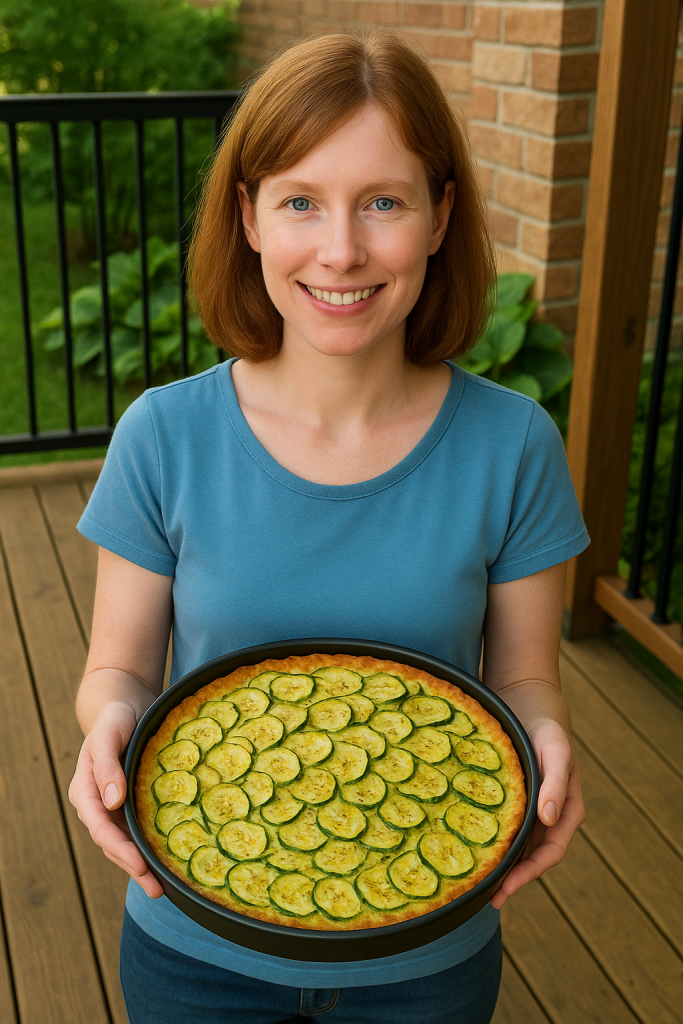
Zucchini scarpaccia is more than just a recipe—it’s a symbol of how traditional dishes can inspire modern wellness. This humble Tuscan tart turns simple zucchini into something extraordinary, proving that healthy eating doesn’t require fancy ingredients or complicated techniques.
As I near the completion of my health and wellness course, I find myself thinking about the legacy I want to leave behind. I don’t just want to live a healthy lifestyle for myself—I want to pass it on. My first mission is to inspire my three sons to embrace a plant-based diet. It’s not an easy challenge, but I believe change begins at home. If I can help others make healthier choices, I can—and must—start with my own family.
This crispy, golden tart is a perfect example of how wellness and pleasure can coexist beautifully. Whether served as a light lunch, a crowd-pleasing appetizer, or a nutritious side dish, it proves that plant-based meals can be both nourishing and delicious. Every bite carries the same wisdom our ancestors understood: seasonal, simple food has the power to sustain both body and soul. Sharing meals like this, made with care and intention, feels like a small but meaningful step toward the healthy lifestyle I hope to pass down—not just to my sons, but to anyone willing to join me at the table.
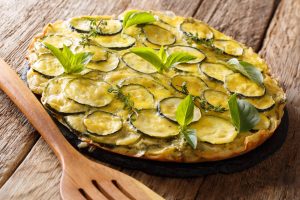
*We may earn a commission for purchases made using our links. Please see our disclosure to learn more.

